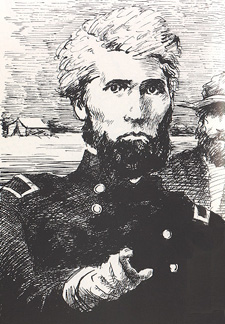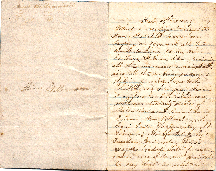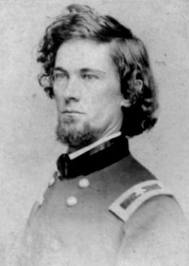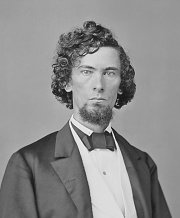Eleazer Paine–The Man, The Myth, The Hair
We are happy to welcome back guest author Meg Thompson!
 Brigadier General Eleazer Paine and I have an interesting relationship. I met him in the dark recesses of the Internet–me, a lonely Civil War widow searching for information about my lost love, Elmer Ellsworth, and Paine?
Brigadier General Eleazer Paine and I have an interesting relationship. I met him in the dark recesses of the Internet–me, a lonely Civil War widow searching for information about my lost love, Elmer Ellsworth, and Paine?
He was just hanging around in the machine, looking like . . . I don’t know what! I have looked at many, many old photos, CDVs, ambrotypes, etc., of people in the middle of the nineteenth century, and I have never seen anyone like Eleazer Paine.
Paine started out in a fairly normal manner for the time. He was born on September 10, 1815, in Ohio, and attended West Point, graduating in 1839. He only briefly served in the Army, participating in the Seminole Wars under General Zachary Taylor, before he resigned his commission, in 1840. He then began studying law and dabbling in the Whiggishly Republican politics of Ohio.
He passed the bar exam in 1843, beginning his law practice soon thereafter. Along with his legal work, and perhaps (the record is unclear) serving as a judge, from 1845 until 1848, Eleazer Paine was active in the Ohio State Militia. During that time, he wrote and published a training manual entitled Military Instructions; Designed for the Militia and Volunteers. His book was not nearly as well received as Elmer Ellsworth’s Complete Instructions For the Recruit In the Light Infantry Drill, written nearly fifteen years later. Nevertheless, Paine was eagerly accepted into the thriving militia movement when he relocated to Monmouth, Illinois to practice law in 1848. While there, he married, raised a family, and became even more involved in the Republican political world.
One of his closest friends was another Illinois lawyer, Abraham Lincoln. Paine had evidently supported Lincoln in his bid for the Illinois State Legislature, (November, 1858), as a letter from Lincoln to Paine still exists, requesting some legal services on behalf of Lincoln’s good friend, Dr. Anson Henry:
E. A. Paine, Esq Springfield,
My dear sir Novr. 19.1858
Inclosed you find a letter and inclosure from my old friend Dr. A. G. Henry–now of Lafayette, Oregon Teritory. Please look after the matter and write him or me.
Well, the election is over; and, in the main point, we are beaten. Still, my view is that the fight must go on. Let no one falter. The question is not half settled. New splits and divisions will soon be upon our adversaries; and we shall [have] fun again. Yours in haste. A. LINCOLN
By 1861, Paine had been elected Colonel of the 9th Illinois Infantry. The 9th was organized in Springfield, Illinois. It was mustered into Federal service on April 26, 1861, for a three-month enlistment. Apparently Paine could not talk his men into signing up for the rest of the War, as the unit was mustered out on July 26, 1861, after losing nine men to disease. Paine mustered out with his troops, but was appointed a Brigadier General of Volunteers two months later. Initially, he was given command of the Third Brigade, First Division in the Army of the Mississippi and sent to Paducah, Kentucky to guard a critical supply depot for the Federal Army.
This was where the trouble started. He ordered all enemy guerrilla fighters caught within his territory to be executed, and he was not very particular as to the facts. If he felt that one of the civilians might be actively supporting the Confederate cause, he considered this to be “guerrilla activity” and ordered the execution. Apparently the executions weren’t exactly regulation either. All General Paine wanted to see was a dead body.
His reputation for cruelty followed him to the command of the Fourth Division of the Army of the Mississippi. He commanded troops at the Battle of New Madrid and the Battle of Island No. 10 in Missouri, and fought in the Siege of Corinth under Rosecrans. Even in combat conditions, the effect of Eleazar Paine’s spiteful nature was not limited to the Confederacy.
On March 14, 1862, Paine was in command of a brigade, part of which was the 51st Illinois. The General angrily brought charges against First Lieutenant Theodore Brown, claiming, “. . .he did . . . at a dwelling house in the town of New Madrid . . . feloniously steal and take away certain goods, to wit one colt, . . . being the property of one Mrs. Craig.” The interesting thing about this charge was what happened to Brown. He was promoted to Captain in July of 1862 and given a variety of responsible recruiting positions in the Union Army until his discharge in May, 1865. Apparently being accused by General Paine did not hurt his reputation in any way.
Perhaps Eleazer Paine tried to control himself in the field, but when he was given command as Head of the District of Western Kentucky, the old issues of brutality began anew. From November, 1862 until April, 1864, his men were deployed to guard the railroads around Union Fort Thomas, and Gallatin, Tennessee, from Confederate raiders. The local citizens lived in fear of Paine’s Reign of Terror.
The best source available, besides Paine’s military record, is the thirty-six page diary of sixteen-year old Confederate sympathizer Alice Williamson, a schoolgirl in Gallatin. She wrote from February to September, 1864, and refers to Paine by a number of colorful epithets such as Old Payne (sic), Our King, Tempest, His Lordship, Old Hurricane, Thunder Storm, and Old Marster. A few of her diary entries include:

Feb. 19th 1864 Our king (old Payne) has just passed. I suppose he has killed every rebel in twenty miles of Gallatin and burned every town. Poor fellow! you had better be praying old Sinner! His Lordship left Tuesday. Wednesday three wagons loaded with furniture came over. I do not pretend to say that he sent them. No! I indeed, I would not. I would not slander our king. Any old citizen can see by going to his (Paynes) palace that his furniture was not taken from Archie Miller’s house & other places near by. He always goes for rebels but-invariably brings furniture. I suppose his task is to furnish the contraband camp. . .
March 3d. Snow all melted and weather fine. Gen. Payne rode out this evening to look at the stock, in his last trip he killed only one man (citizen, he always kills citizens when he cant find soldiers) swears he will kill every man in Gallatin and Hartsville if bush whacking isn’t stopped shortly.
March 12th Old Payne dined at Mrs. Hales today: every one despises him but are afraid to show it. Yesterday he went up the country a few miles to a Mr. Dalton’s whose son came home from the Southern Army the day before and had the same day taken the Amnesty Oath. Riding up to the door he enquired of Mr. Dalton if his son was at home but before he answered his son came to the door. Old Nick then told him to get his horse and go with him. After insulting the father he carried his son a half mile away and shot him six times. One of Payne’s escort hearing the young man groan with pain placed a pistol to his temple and remarked, I will stop that, sir, he shot him again. But this is nothing new this is the fifth man that has been shot in this way, besides numbers that have been carried off by scouts and never return.
By April, information concerning General Paine’s brutal depredations had gotten as far as the Western Army’s high command. Paine was removed from his post on April 29, 1864, by the orders of Major General William T. Sherman, who transferred him to Tullahoma, Tennessee. The following is the text of the order as published in The War of the Rebellion: a Compilation of the Official Records of the Union and Confederate Armies:
April 29, 1864
General Rousseau,
Nashville, Ten: Order General Paine and the regiment now at Gallatin to Tullahoma, and give him charge of the defense of the road, embracing Duck and Elk River bridges. Replace Paine’s troops by some guard at the bridges. The road north of Nashville is not important to me but the south is vital. Remember to place gun racks and muskets in all the forts and strong buildings, so that citizens may, if necessary, assist in the defense of Nashville. But there is no danger there now and cannot be for a month to come.
W.T. Sherman
Unfortunately, Tullahoma now became the focus of the General’s brutality and he slipped immediately back into his old, bad habits. Paine was quickly put under investigation, and a Congressional inquiry into his actions in Kentucky found him guilty and punished him by reprimand at Paducah.

General Paine resigned from the Army in April, 1865 and returned to Monmouth, where he lived until just before his death in 1882. It is written that he had a large flagpole in the front yard of his Monmouth home, whereupon he flew a “secesh” flag he had taken from an Alabama regiment.
Eleazer was not the only General Paine in the Union Army. Paine had a first cousin, Wisconsonian Halbert E. Paine, who also served as a general. He, too, was a lawyer, a politician, and a friend of Lincoln. Halbert Paine led the Third Division of the Army of the Gulf in an assault on Priest Gap during the Battle of Port Hudson, where he suffered a wound that required the amputation of his leg. Upon recovery, General Halbert Paine commanded troops in the defenses of Washington, D. C., during Jubal Early’s raid in 1864. He resigned from the Army on May 15, 1865, returned to Wisconsin, and served in the U. S. Congress for three terms.

Apparently the wild, uncontrollable hair was a family trademark. There is only one image of General Eleazer Paine in which his hair is remotely under control, and his expression is not quite so . . . shall we say, “intense?” It comes from the Ohio Historical Society (http://ohiohistory.wordpress.com/2011/08/15/do-you-know-this-man/) and at present the Society claims he is “unknown.”
I disagree. I’d know that face anywhere.
Authored By Meg Thompson. Visit her blog.
I AM A PAINE N MY HAIR IS SOMEWHAT THE SAME . JUST MADE ME KNOW HE WAS RELATED
Gallatin is in Tennessee, not Kentucky btw.
Thanks–done!
Hi Meg…..I am the publisher of The Old Sumner Times-Record here in Gallatin, TN. I have also conducted The Gallatin Ghost Walk history/mystery experience weekends in October. Eleazar Payne is a big part of our Walk. The tour concludes on our public square, on the very spot where Payne hanged over 100 (innocent) citizens on trumped up charges. Our square is very haunted. Payne’s victims are no doubt a majority of the poor ‘spirits.’ We are on facebook.
So glad Ol’ Payne isn’t forgotten.What a character! Glad you are keeping his somewhat terrifying memory alive. Hope to see you some day.
Is this the same General Paine that killed over 100 people including a ten year old boy.??? Got to love the union side they were such honorable men (eye roll) typical left wing lawyer.
I’ve lived in Gallatin all my life and never heard of this despicable evil person until i read something about him this year. He was just pure evil, unlawfully killing 100 people in my hometown by either hanging or shot to death. Paine had a ex soldier dragged out of his fathers house and shot the ex Confederate soldier AFTER he took the oath of allegiance to the union, after he told Paine he took the oath and showed the papers to Paine, Paine told him basically he didn’t care and shot the ex soldier 6 times, the soldiers father watched him get shot and killed. He would throw out women and children out on the streets so his men could have a comfortable place to sleep. He made curfews, taxed everything, take livestock for his men to eat. If the town of Gallatin didn’t do as the General said he would execute them on the spot or if the answer wasn’t what he wanted to hear he would execute them. He had it in his mind that most of the Gallatin town were a spy and were executed. If anyone has or had any sympathy for this kind of person are just as Looney as he was. I just hope God had mercy on his cold evil soul.
Indeed he was pure evil. As the Civil War diary of young Alice Williamson diary begins, “Today was a good day in Gallatin: no one was hanged.”
I have been telling the story of Paine’s atrocities for 15 years at the Gallatin Ghost Walk. Many people don’t know about him.
During Fall for the past couple of years Eleazer Paine seems to raise his tousled head. I am beginning to think he is like other Hallowe’en terrors! Someone ought to make a movie! BOO!
…I am tour creator/presenter The Gallatin Ghost Walk. Our Square is so very haunted and gets so much more active as November, anniversary of Payne coming to town, approaches.
When is the ghost walk? I’ve been wanting to do this for a while now I just never had the chance to.
Every Friday and Saturday in October. 615-512-5299
According to Kentucky historian Berry Craig, “In the last analysis evidence is strong that the local animus toward Paine, perpetuated by nineteenth and twenty century historians, was rooted in his strongly held abolitionist views, in his support for the enlistments of African Americans into the Union forces and in his belief in black equality with whites.”
Paine was investigated for and never found guilty of any serious crimes. Are we to believe the accusations of a pro-slavery community or the United States Military and justice system?
I am a cousin to John Robertson Massey of Fayetteville, Lincoln, Tn. He was named for Nashville pioneer, James Robertson and long hunter and Nashville founding pioneer, John Rains. who was his grandfather. He was named John after him. He was summarily executed along with two other men at the Fayetteville town square in the summer of 1864 by Federal troops under Gen. Eleazer Paine. Paine and his troops then rode to Mulberry, where they executed 7 more men. In retaliation, A “Confederate sympathizer” named Robert “Bob” Blackwell, with other middle Tennessee men, raided a Federal outpost at Shelbyville where they took about 20 Federal prisoners. The prisoners were taken to Fayetteville where they were questioned. out of the 20, half were sent on to General Forrest, the other 10 were taken outside of Fayetteville to the top of Well’s Hill where they were executed. A note was pinned to one of them that read “Remember John Massey”.
Can anyone give me information on the Dalton family mentioned in Alice Williamson’s diary? I have a civil war document signed by Brigadier General E A Paine giving D W Dalton permission to travel across enemy lines to go to work in Gallatin. I’m trying to figure out if there is any connection but her diary doesn’t mention first names. Thanks